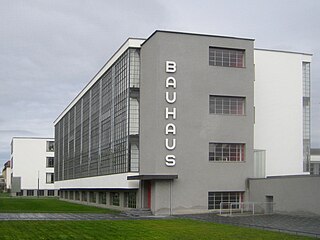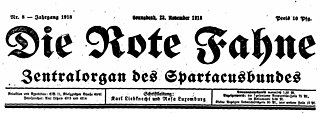
Weimar culture was the emergence of the arts and sciences that happened in Germany during the Weimar Republic, the latter during that part of the interwar period between Germany's defeat in World War I in 1918 and Hitler's rise to power in 1933. 1920s Berlin was at the hectic center of the Weimar culture. Although not part of the Weimar Republic, some authors also include the German-speaking Austria, and particularly Vienna, as part of Weimar culture.

Walter Adolph Georg Gropius was a German-born American architect and founder of the Bauhaus School, who is widely regarded as one of the pioneering masters of modernist architecture. He was a founder of Bauhaus in Weimar and taught there for several years, becoming known as a leading proponent of the International Style. Gropius emigrated from Germany to England in 1934 and from England to the United States in 1937, where he spent much of the rest of his life teaching at the Harvard Graduate School of Design. In the United States he worked on several projects with Marcel Breuer and with the firm The Architects Collaborative, of which he was a founding partner. In 1959, he won the AIA Gold Medal, one of the most prestigious awards in architecture.
Walter Ze'ev Laqueur was a German-born American historian, journalist, political commentator, and Holocaust survivor. He was an influential scholar on the subjects of terrorism and political violence.

Henry Wickham Steed was an English journalist and historian. He was editor of The Times from 1919 to 1922.

The Berliner Tageblatt or BT was a German language newspaper published in Berlin from 1872 to 1939. Along with the Frankfurter Zeitung, it became one of the most important liberal German newspapers of its time.

Sir Horace George Montagu Rumbold, 9th Baronet, was a British diplomat. A well-travelled man who learned Arabic, Japanese and German, he is largely remembered for his role as British Ambassador to Berlin from 1928 to 1933 in which he warned of the ambitions of Hitler and Nazi Germany.

Paul Gustav Emil Löbe was a German politician of the Social Democratic Party of Germany (SPD), a member and president of the Reichstag of the Weimar Republic, and member of the Bundestag of West Germany. He died in Bonn in 1967.
Neues Deutschland is a left-wing German daily newspaper, headquartered in Berlin.

Die Rote Fahne was a German newspaper originally founded in 1876 by Socialist Worker's Party leader Wilhelm Hasselmann, and which has been since published on and off, at times underground, by German Socialists and Communists. Karl Liebknecht and Rosa Luxemburg famously published it in 1918 as organ of the Spartacus League.
Jewish Bolshevism, also Judeo–Bolshevism, is an antisemitic and anti-communist conspiracy theory that claims that the Russian Revolution of 1917 was a Jewish plot and that Jews controlled the Soviet Union and international communist movements, often in furtherance of a plan to destroy Western civilization. It was one of the main Nazi beliefs that served as an ideological justification for the German invasion of the Soviet Union and the Holocaust.
A Protocol of 1919 is a fabricated text published as an appendix in some editions of The Protocols of the Elders of Zion. It was purportedly found on 9 December 1919 among the documents of a Jewish Red battalion commander killed in the Estonian War of Independence. The document's supposed authors, the "Israelite International League", gloat over their success at reducing the Russian people to "helpless slaves", and urge their fellow Jews to "excite hatred" and "buy up Government loans and gold", in order to grow in "political and economic power and influence". The text has been cited, as with other antisemitic canards, as evidence for the antisemitic belief that the Jews are conspiring to take over the world.

Fyodor Viktorovich Vinberg was a right-wing Russian military officer, publisher and journalist.

The Protocols of the Elders of Zion is a fabricated text purporting to detail a Jewish plot for global domination. Largely plagiarized from several earlier sources, it was first published in Imperial Russia in 1903, translated into multiple languages, and disseminated internationally in the early part of the 20th century. It played a key part in popularizing belief in an international Jewish conspiracy.
Hapoel Hatzair was a Zionist group active in Palestine from 1905 until 1930. It was founded by A.D. Gordon, Yosef Aharonovich, Yosef Sprinzak and followed a non-Marxist, Zionist, socialist agenda. Hapoel Hatzair was a pacifist, anti-militarist group that sought to establish a Jewish foothold in Palestine through manual labor and agricultural settlement.
The Wirtschaftliche Aufbau-Vereinigung was a Munich-based counterrevolutionary conspiratorial group formed in the aftermath of the German occupation of Ukraine in 1918 and of the Latvian Intervention of 1919. It brought together White Russian émigrés and early German Nazis who aimed to overthrow the governments of Germany and the Soviet Union, replacing them with authoritarian régimes of the far right. Aufbau was also the name of the organization's periodical.

Max Eitingon was a German medical doctor and psychoanalyst, instrumental in establishing the institutional parameters of psychoanalytic education and training.
Volkswacht was a social democratic newspaper published in Danzig, Germany from 1910 to 1919. Initially, Volkswacht was published weekly. As of 1913, it was published twice weekly. In 1914 it was converted into a daily newspaper. The newspaper masthead carried the slogan Organ für die werktätige Bevölkerung in Westpreußen. It was issued as a publication of the Free Trade Unions.

The 1919 Illinois Fighting Illini football team was an American football team that represented the University of Illinois in the Big Ten Conference during the 1919 college football season. In their seventh season under head coach Robert Zuppke, the Fighting Illini compiled a 6–1 record and outscored their opponents by a combined total of 91 to 48.
Aufbau is a term which was used in publications from 1919 to 1947 in the German language. The term can be translated as "structure", "construction" or as "rebuilding", "reconstruction". Peter Galison advocated its use as a "keyword", in the sense used by Raymond Williams in Keywords: A Vocabulary of Culture and Society.











